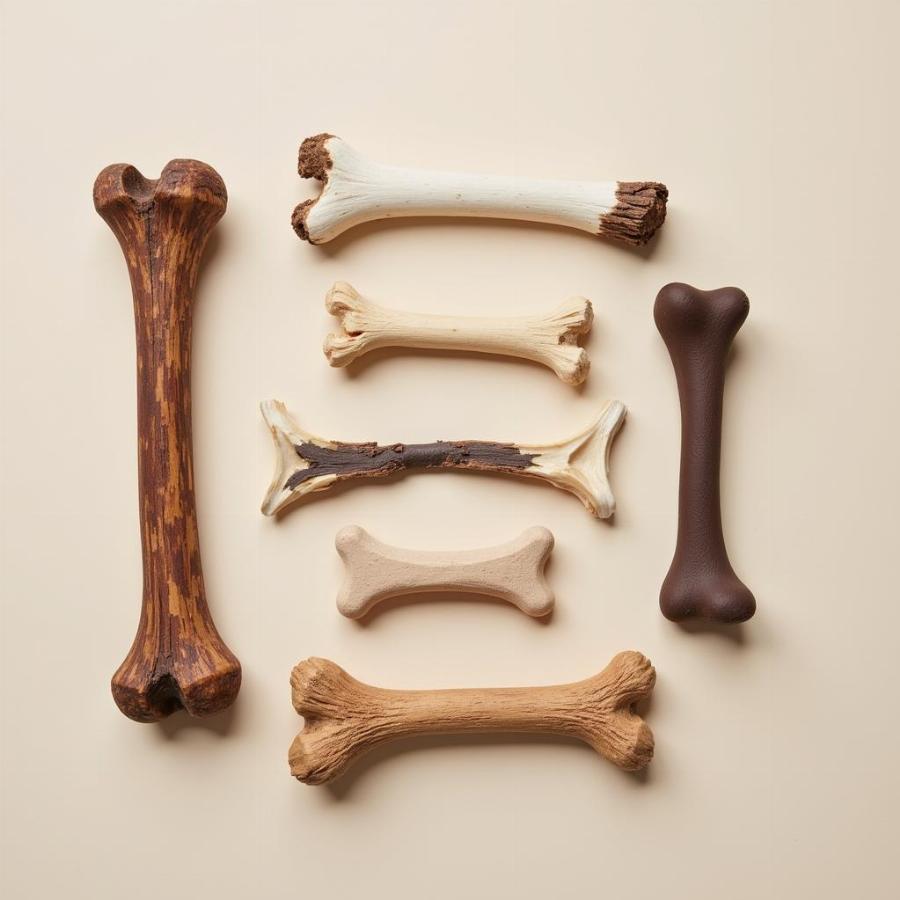Choosing the best chew bone for your dog can feel like navigating a maze. With so many options available, it’s understandable to feel overwhelmed. From durable nylon bones to flavorful natural options, finding the perfect chew for your furry friend depends on their size, chewing habits, and overall health. This guide will help you understand the different types of chew bones, their benefits, and potential risks, so you can confidently choose the best chew bone for your canine companion.
Types of Chew Bones for Dogs
There’s a wide variety of chew bones on the market, each designed to cater to different needs and preferences. Understanding the differences between these types is crucial for making an informed decision.
Natural Chew Bones
Natural chew bones are derived from animal sources and offer a range of benefits, including dental health improvement and satisfying your dog’s natural chewing instincts. Popular choices include beef bones, antlers, and bully sticks. However, it’s important to choose appropriately sized bones to prevent choking hazards. Also, be aware that some natural bones can splinter, so supervision is always recommended.
Nylon Chew Bones
Nylon bones are known for their durability and long-lasting nature. They are designed to withstand even the most aggressive chewers. These bones often come in different flavors and textures to keep your dog engaged. While generally safe, it’s important to monitor your dog for excessive wear and tear on the nylon, as small pieces could potentially be ingested.
Rubber Chew Bones
Rubber chew bones are another durable option, often featuring textured surfaces to help clean your dog’s teeth. They are a good choice for dogs who enjoy playing fetch and chewing. Look for rubber bones made from natural, non-toxic materials.
How to Choose the Right Chew Bone
Selecting the appropriate chew bone is vital for your dog’s safety and enjoyment. Consider these factors:
Size and Breed
A small bone can be a choking hazard for a large dog, while a large bone can be too much for a small dog to handle. Choose a bone that is appropriately sized for your dog’s breed and age.
Chewing Habits
Is your dog a gentle chewer or a power chewer? For aggressive chewers, durable nylon or rubber bones are recommended. For gentler chewers, natural bones or softer chew toys might be suitable.
Health Concerns
If your dog has any allergies or dietary restrictions, carefully examine the ingredients of the chew bone. Some natural bones may be high in fat or protein, which could be problematic for certain dogs. Consider calcium supplements for dogs if your vet recommends it.
 Variety of Dog Chew Bones: Nylon, Natural, and Rubber
Variety of Dog Chew Bones: Nylon, Natural, and Rubber
Benefits of Chew Bones
Chew bones offer numerous benefits beyond simply satisfying your dog’s chewing instinct.
Dental Health
Chewing helps scrape away plaque and tartar buildup, promoting healthy teeth and gums. Many chew bones are designed with textures and ridges to maximize this cleaning action. You might also consider best dental powder for dogs for added dental care.
Mental Stimulation
Chewing can be a mentally enriching activity for dogs, helping to alleviate boredom and prevent destructive behaviors. Providing a variety of chew bones can keep your dog engaged and entertained.
Physical Exercise
Chewing can provide a form of physical exercise, especially for dogs with limited mobility. The act of chewing strengthens jaw muscles and provides a healthy outlet for energy.
What are the best chew bones for puppies?
Puppies have different chewing needs than adult dogs. Softer chew toys and specially designed puppy chews are best for their developing teeth and gums. Avoid hard bones that can damage their teeth.
What if my dog swallows a piece of bone?
While rare with appropriate supervision and bone selection, if your dog swallows a large piece of bone, contact your veterinarian immediately. This could cause digestive blockage. If you’re wondering are nylon bones edible for dogs, they are not designed to be digestible.
Are rawhide chews safe for dogs?
While popular, rawhide chews can pose choking hazards and digestive issues. Opt for safer alternatives like bully sticks or bison hot dogs for a satisfying chew.
Can I give my dog cooked bones?
Never give your dog cooked bones. Cooked bones can splinter easily, causing serious internal injuries. Stick to raw, appropriately sized bones or other safe chew toys. You can also offer treats like chicken gizzards as a healthy alternative.
Conclusion
Finding the best chew bone for your dog requires careful consideration of their individual needs and chewing habits. By understanding the various types of chew bones available, their benefits, and potential risks, you can make an informed decision that promotes your dog’s health, happiness, and overall well-being. Remember to always supervise your dog while they are chewing and replace worn-out bones promptly.
FAQ
- What are the safest chew bones for dogs?
- How often should I give my dog a chew bone?
- Can chew bones help with teething puppies?
- Are there any chew bones I should avoid giving my dog?
- How can I tell if a chew bone is too small for my dog?
- What should I do if my dog breaks a chew bone into small pieces?
- Can I give my dog a chew bone if they are on a special diet?
Further Reading
- Best Dog Toys for Aggressive Chewers
- Dental Care for Dogs
- Understanding Your Dog’s Chewing Behavior
Beaut Dogs is your go-to resource for all things related to dog care. We offer expert advice on breed selection, health, nutrition, training, and more. When you need support, please contact us at Email: [email protected] for detailed and accurate answers from Beaut Dogs. Visit https://beautdogs.com today to discover the wonderful world of dogs and learn how to care for them best!